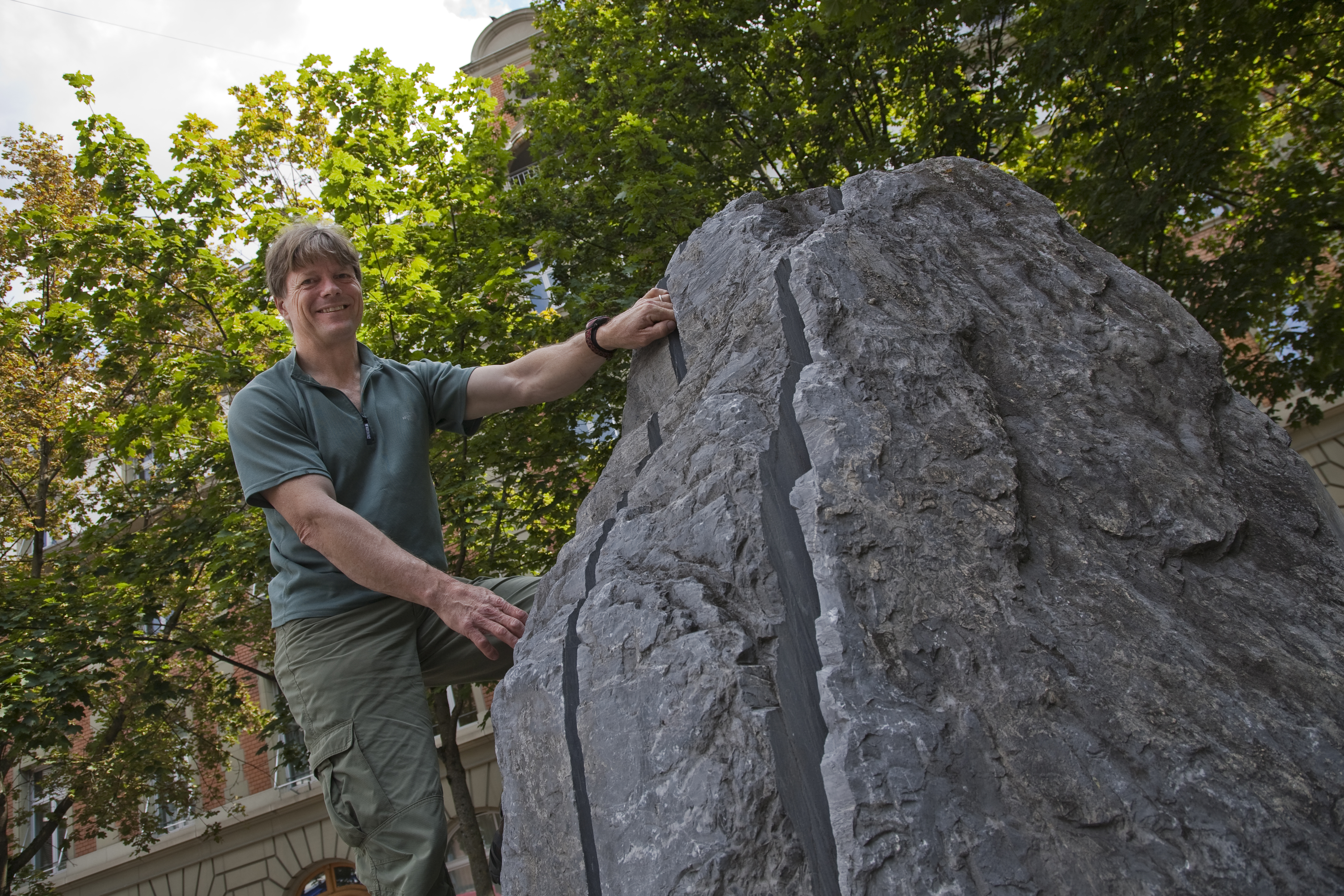
“This sort of journey is about endurance”

Most people wouldn’t think of climbing even one mountain let alone an entire mountain border. But John Harlin III has resumed his attempt to do just that.
The American climber and writer has returned to the Swiss Alps to complete his Swiss Borders adventure, circling the country of his childhood.
Harlin, who kayaked and mountain biked Switzerland’s northern and western borders last year, spoke to swissinfo.ch as he prepared to complete his journey by hiking and climbing the alpine section that divides Switzerland from Austria, Italy and France.
With all the zig-zags, it is a 1,000-kilometre stretch of frontier that because of its mountainous terrain includes a knee-battering 220,000 vertical metres of ascent and descent. Harlin’s pictures, videos and written reports of the ups and downs, aches and pains – and insights – are available exclusively on swissinfo.ch.
swissinfo.ch How do you feel at the start of the final part of Border Stories?
John Harlin: I have mixed emotions, I can’t wait to see this part of the country and I’m in shape to do it. But that’s the part that makes me nervous, I’m going to have to prove it because there is so much vertical elevation gain.
swissinfo.ch A climber is normally in his prime in his 20s and 30s. You are in your 50s. How will you cope?
J.H.: Dad gifted me with a body that keeps on going and I’ve been training. But this sort of journey is about endurance. I don’t have the speed I did as a young man, nor the power but I should be able to keep going and that’s not degraded by age nearly as much.
swissinfo.ch What are you most looking forward to?
J.H.: The diversity. I’m looking forward to the high peaks. I’m looking forward to the Matterhorn. I’ve climbed two of the ridges and I’m intending to go up a third. And the traverse from there over to the Dent d’Herens from a technical climbing perspective is very interesting. But I’m also looking forward to the Ticino area and the more tropical feeling there.
swissinfo.ch What are you most dreading? Last year you had an accident and broke both feet.
J.H.: That happened on a section of rock that I knew was going to be the most dangerous on the entire journey. The ridge where the accident happened is where the Swiss-French border leads up to Mont Dolent where the Swiss, Italian and French borders come together. It’s the only logical way if you are following the border.
I had misfortune but also fortune – it could have been a lot worse. Technical climbing is my passion. I’m not dreading the parts that are difficult. My major concern is all the downhill and how that will affect my knees. I spoke with a knee surgeon and he recommended a couple of simple exercises and said by doing them I should be able to do 30,000 vertical metres a week, no problem.
swissinfo.ch Is it possible that you will sometimes have to say it’s just too dangerous today, it’s snowing, it’s blowing a gale…
J.H.: The weather is the other big concern. If it’s bad, it can stop you in your tracks if you’re in the Alps. If there are particular peaks I want to go over but the weather is bad but will change for the better in a couple days, then I can wait it out. I can also drop down lower and hike trails regardless of the weather.
swissinfo.ch How much does your pack weigh?
J.H.: The main additional weight is water, of course, and food. So it depends on how many days I need to carry food for. That all depends on which section I’m doing and how often I stay at mountain huts. I weighed it before I added the camera gear and it was about 14kg. The camera gear is another 2-3kg but that’s without the food so I’m going to have to purge more from my pack.
swissinfo.ch Will there be times when you look out your tent and think, I don’t really want to go on?
J.H.: This is the longest journey I will have ever done. I know there are going to be times when I’d rather just sit and relax and maybe go down to a lake on the border like Lake Lugano and go for a swim and hang out for a while. But that’s part of the personal challenge for me to push on through those moments.
swissinfo.ch The project is called Border Stories. What are you hoping to learn about this stretch of the border?
J.H.: What’s so fascinating to me about European borders in general but certainly the Swiss border is how they came to be, and it’s through turmoil and strife over centuries where one clan or prince or emperor set the borders and then they were fought over. But Switzerland has had relatively stable borders for a long time by European standards.
By the time I reach Mont Dolent I’ll have passed through four language regions: starting with German, then Romansh, Italian for the bulk of it and ending with French. That’s just a taste of the cultural differences.
swissinfo.ch When you’ve done this will you have Switzerland out of your system?
J.H.: Ask me that at the end! I think I’ll have walking high mountains and ridges out of my system for a while.
John Harlin began his attempt to follow the entire Swiss border in June 2010. But barely a week in, he broke both of his feet in a mountaineering accident.
Once the bones had healed Harlin resumed his adventures. Last autumn he paddled the Rhine, cycled around Schaffhausen, biked the crest of the Jura and kayaked across Lake Geneva.
This summer he is travelling clockwise from eastern Switzerland to end near the site of his accident, the Mont Dolent, where the borders of Italy, France and Switzerland come together.
To follow Switzerland’s mountain border, John Harlin will ascend and descend around 220,000 vertical metres. It is the equivalent of going up and down Mount Everest – from the sea to summit – 12 times.
Lowest point: The borderline running across Lake Maggiore (193m)
Highest point: The top of the Dufourspitze (4,634m)
John Harlin III was born in 1956 and grew up in Germany and Leysin, Switzerland. After his father, John Harlin II, died in 1966 attempting to be the first to climb the direct route up the north face of the Eiger, his family returned to the United States to live.
He finally climbed the Eiger north face himself in 2005, a feat that was the focus of the popular IMAX film “The Alps”. John is the editor of the “American Alpine Journal” (published by the American Alpine Club since 1929) and a contributing editor to “Backpacker” magazine.

In compliance with the JTI standards
More: SWI swissinfo.ch certified by the Journalism Trust Initiative





























You can find an overview of ongoing debates with our journalists here . Please join us!
If you want to start a conversation about a topic raised in this article or want to report factual errors, email us at english@swissinfo.ch.